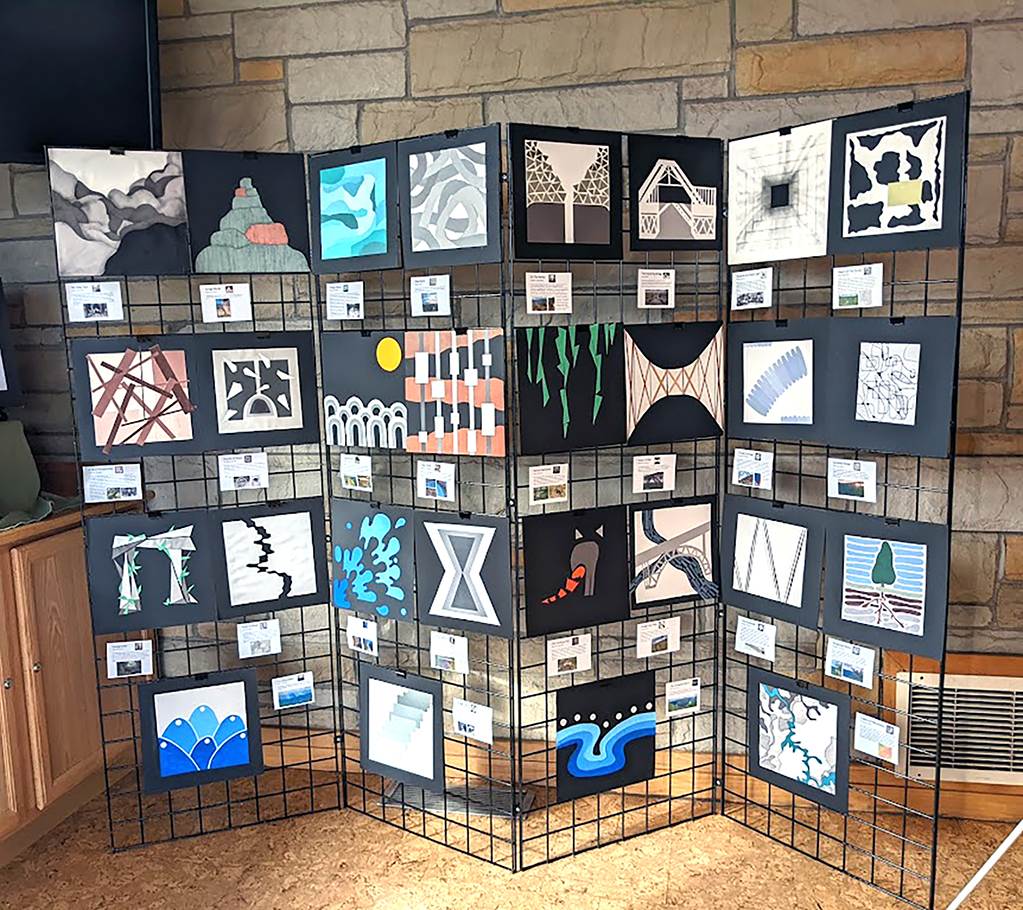Radford University
Anyone who makes a trip to the New River Gorge National Park and Preserve this spring will have a chance to see some uniquely inspired art from Radford University’s design students.
Last fall, the gorge was the catalyst for a project in Laura Kimball’s Fundamentals class, a first-year modular course that starts design majors on their educational journey.
Normally, these projects would find a home on campus, but as Radford builds its new multi-million-dollar Center for Adaptive Innovation and Creativity, display space is limited.
This year, with the gorge taking center stage in a major course assignment, the Canyon Rim Visitor’s Center makes for a perfect gallery.
Since 2018, Kimball has used America’s National Parks to spark creativity for an assignment that marries abstract art to inspiration. This year, West Virginia’s New River Gorge, which winds for 53 miles through some of the country’s most beautiful scenery, served as the focal point.
“Students start with information-gathering research with simple prompts to guide them,” said Kimball. “What is the history of this place? What is its significance? Why do people visit? Describe the ecosystem.”
For the assignment, students must create both 2D and 3D abstract paper art projects to capture the spirit of the New River Gorge as inspiration. They are encouraged to be creative and follow their own interests in this.
As a result, some students focused on the river itself while others gravitated toward the wildlife, the region’s history, the bridge, or environmental issues.
Monica Rivera centered her project on the gorge’s most famous landmark, its impressive steel arch bridge that stretches over 3,000 feet high above the world’s second oldest river.
“When I started my research, I was actually trying to stay away from the bridge because I felt like everybody would pick that,” she said.
But the more research she did, the more she became interested in the community interactions with the structure.
For her 3D project, she captured the parachuters who celebrate Bridge Day by launching themselves from the structure. Her 2D projects express the point of view of kayakers passing beneath the bridge and people rapeling off it.
Rivera said she struggled at first with the abstract nature of the assignment but overcame it when she stopped thinking about it as a graded assignment.
“I felt proud that I got over that hurdle,” she said. “Being able to improve on my abstract thinking was really rewarding.”
Stephanie Carr found herself drawn to the Native American heritage of the area.
“Just to put it in perspective,” she said, “the natives that lived in this area were there 5,000 years before the pyramids of Egypt were built.”
Her project took a traditional symbol of European education and authority, a book, and weathered it with water and fire. She then placed images and symbols associated with Native American cultures on the pages.
Carr said the objective is for people to become curious and consider the way history is told. She hopes visitors to the center will be inspired to research the people who lived there first.
Kimball said that having the students’ work on display, especially in such a public place, plays an important role in their education.
“Showcasing underclassman projects supports retention and a sense of belonging to the program and the university,” said Kimball. She also notes that it instills pride and validation in the accomplishment.
Hayley Walker agrees.
“I’m so thrilled to have my work displayed at a National Park site,” said Walker. “I love finding places to hike and learning about the trails that I’m walking on, so I’m glad my work has found its way to one of my happy places.”
Dave Beiri, the District Supervisor at Canyon Rim Visitor Center, said he admires the creativity and engagement the artwork shows and sees the impact of the art at the center.
“Visitors have enjoyed looking at the display,” Beiri said. “All of the resources in this park are not always apparent to people, especially if they are just passing through the visitor center. I think this display maybe got people to think about the park in a different way.”
The exhibit runs from through April 27. The Preserve Canyon Rim Visitor Center is located at 162 Visitor Center Road in Lansing, West Virginia.



